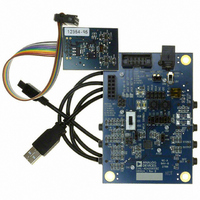EVAL-ADAU1761Z Analog Devices Inc, EVAL-ADAU1761Z Datasheet - Page 45

EVAL-ADAU1761Z
Manufacturer Part Number
EVAL-ADAU1761Z
Description
Eval Board For ADAU1761
Manufacturer
Analog Devices Inc
Series
SigmaDSP®r
Specifications of EVAL-ADAU1761Z
Main Purpose
Audio, CODEC
Embedded
Yes, DSP
Utilized Ic / Part
ADAU1761
Primary Attributes
Stereo, 24-Bit, 8 ~ 96 kHz Sampling Rate, GUI Tool
Secondary Attributes
I²C and GPIO Interfaces, 2 Differential and 1 Stereo Single-Ended Analog Inputs and Outputs
Silicon Manufacturer
Analog Devices
Core Architecture
SigmaDSP
Silicon Core Number
ADAU1761
Silicon Family Name
SigmaDSP
Application Sub Type
Audio
Lead Free Status / RoHS Status
Lead free / RoHS Compliant
Available stocks
Company
Part Number
Manufacturer
Quantity
Price
Company:
Part Number:
EVAL-ADAU1761Z
Manufacturer:
Analog Devices Inc
Quantity:
135
DSP CORE
SIGNAL PROCESSING
The ADAU1761 is designed to provide all audio signal processing
functions commonly used in stereo or mono low power record
and playback systems. The signal processing flow is designed
using the SigmaStudio software, which allows graphical entry
and real-time control of all signal processing functions.
Many of the signal processing functions are coded using full,
56-bit, double-precision arithmetic data. The input and output
word lengths of the DSP core are 24 bits. Four extra headroom
bits are used in the processor to allow internal gains of up to
24 dB without clipping. Additional gains can be achieved by
initially scaling down the input signal in the DSP signal flow.
ARCHITECTURE
The DSP core consists of a simple 28-/56-bit multiply-accumulate
(MAC) unit with two sources: a data source and a coefficient
source. The data source can come from the data RAM, a ROM
table of commonly used constant values, or the audio inputs to
the core. The coefficient source can come from the parameter
RAM or from a ROM table of commonly used constant values.
The two sources are multiplied in a 28-bit fixed-point multiplier
and then the signal is input to the 56-bit adder; the result is usually
stored in one of three 56-bit accumulator registers. The accumu-
lators can be output from the core (in 28-bit format) or can
optionally be written back into the data or parameter RAMs.
ROM CONSTANTS,
AUDIO INPUTS)
DATA SOURCE
(DATA RAM,
(ACCUMULATORS (3), dB CONVERSION,
28
BIT OPERATORS, BIT SHIFTER, ...)
Figure 67. Simplified DSP Core Architecture
56
DATA OPERATIONS
TRUNCATOR
OUTPUTS
56
56
28
COEFFICIENT SOURCE
(PARAMETER RAM,
ROM CONSTANTS)
28
TRUNCATOR
28
56
Rev. C | Page 45 of 92
PROGRAM COUNTER
The execution of instructions in the core is governed by a program
counter, which sequentially steps through the addresses of the
program RAM. The program counter starts every time that a
new audio frame is clocked into the core. SigmaStudio inserts
a jump-to-start command at the end of every program. The
program counter increments sequentially until it reaches this
command and then jumps to the program start address and
waits for the next audio frame to clock into the core.
FEATURES
The SigmaDSP core was designed specifically for audio processing
and therefore includes several features intended for maximizing
efficiency. These include hardware decibel conversion and audio-
specific ROM constants.
STARTUP
Before the DSPRUN bit is set or any settings are written to the
parameter RAM, the DSP core must be enabled by setting the
DSPEN bit in Register R61 (Address 0x40F5).
The following steps should be performed every time that a new
program is loaded to the SigmaDSP core, or any time that the
DSPRUN bit is disabled and reenabled.
1.
2.
3.
4.
5.
Changing any register setting or RAM can cause pops and
clicks on the analog outputs. To avoid these pops and clicks,
mute the appropriate outputs using Register R29 to Register R32
(Address 0x4023 to Address 0x4026). Unmute the analog out-
puts after the startup procedure is completed.
Set the DSPSR[3:0] bits in Register R57 (Address 0x40EB)
to 1111 (none).
Set the DSPRUN bit in Register R62 (Address 0x40F6) to 0.
Download the rest of the registers, the program RAM, and
the parameter RAM.
Set the DSPRUN bit in Register R62 to 1.
Set the DSPSR[3:0] bits in Register R57 to the operational
setting (default value is 0001).
ADAU1761





















